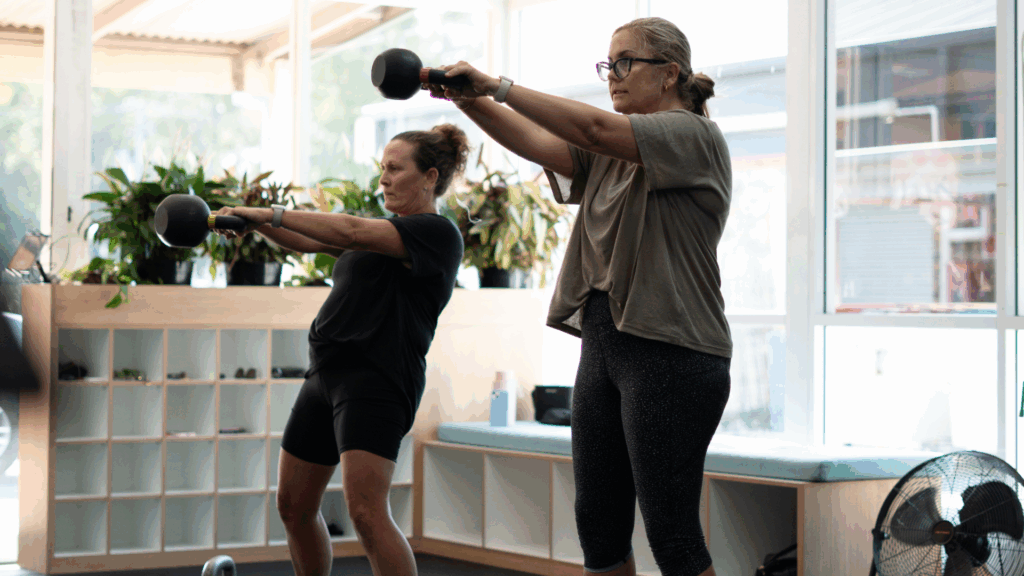Hey, while you’re here reading this just a little about me so you know who’s writing it.
I run a gym called Movement Innovation in Burleigh. Been a personal trainer for 13 years and I’m keen to educate you in a simple and easy-to-understand way because we all know there’s a lot of inaccurate stuff out there.
Anyway. Enough about me. Let’s get into this whole functional training thing everyone’s banging on about and why it’s become such a buzz word.
What Is Functional Training?
Functional training is about preparing your body for the physical demands of life, sport, and work. It means building strength and control across multiple joints and muscle groups in a way that improves how you move, not just how much you lift or how you look.
Instead of machines that isolate a single muscle, functional training uses free weights, sleds, cables, and bodyweight movements to train your body to work as a system. You’re training patterns, not parts.

Where It All Started
Functional training first gained traction in the 80s and 90s when physiotherapists used it to help people recover from injuries. It wasn’t long before trainers realised its potential to improve strength and movement patterns, not just for rehab but for sports performance and general physical ability. By the early 2000s, it was being incorporated more widely in fitness programs to help people move better and reduce injury risk.

Why It Matters
Functional training helps you manage load, absorb force, and move with better control. That’s important whether you’re turning quickly on the tennis court, pushing through surf, carrying heavy gear, or just trying to stay physically capable as you get older.
Some key benefits include:
• Rotational strength and control (used in sports like golf or tennis)
• Better trunk and hip connection (important for running, hiking, and lifting)
• Stability under load (for physical jobs, gym training, or general strength)
• Joint control and coordination (especially important post-injury or with age)
This training builds durability and performance. It prepares you to stay active, avoid injury, and do the things you care about more comfortably and confidently.

How It’s Different From Traditional Training
Traditional gym programs usually separate training by muscle groups. That works if you’re training for size or want to focus on a weak area. But if your goal is to improve how you move and feel day-to-day, training needs to reflect that.
Functional training uses movement-based patterns: squatting, hinging, pushing, pulling, carrying, and rotating. These movements use multiple joints and muscles working together.
Some examples:
• Split squats instead of leg extensions—because you rarely use both legs equally when moving or changing direction
• Carries or anti-rotation holds instead of crunches—because your core’s job is to brace and resist movement
• Sled pulls or standing rows instead of seated machines—to match how you move and load your body in the real world
Good functional training isn’t about making exercises look complicated. It’s about choosing movements that carry over to how you actually use your body.

What a Good Functional Program Looks Like
A solid program covers all the major movement patterns, trains both sides of the body, and blends slow strength with faster, more powerful work. It includes:
• Full range of motion
• Unilateral exercises (training one side at a time)
• Tempo work to build control
• Power work like throws, jumps, or sled pushes•
• Balance and coordination challenges
Examples:
• Bulgarian split squats for leg strength and hip control
• Sled pushes for trunk and lower body power
• Landmine presses for shoulder strength and core connection
• Carries (farmer, suitcase) for posture, grip, and trunk stability
• Crawls and bear holds for coordination and total-body strength

Who It’s For
This training suits anyone who wants to move better, stay strong, and reduce injury risk. That could be:
• People recovering from injury
• Adults who want to stay physically capable
• Athletes who want gym work to transfer to sport
• Workers who use their body all day
• Parents and grandparents who want to stay active
You don’t need to be fit already. Functional training meets you where you’re at and progresses based on what you can handle.

Why We Use It At Our Gym
We program functional training into our clients workouts because it delivers what our members care about: feeling strong, staying active, and being able to do the things they enjoy outside the gym.
If you have no idea where to start or if you’re even doing it properly, click the link, jump on our trial, and we’ll teach you all the ins and outs, and make sure you feel confident before trying to go heavier or push yourself too far.
P.S. The trial’s free.
Written by Luke Nivison-Smith, the founder of Movement Innovation, with over 13 years of personal training experience.

